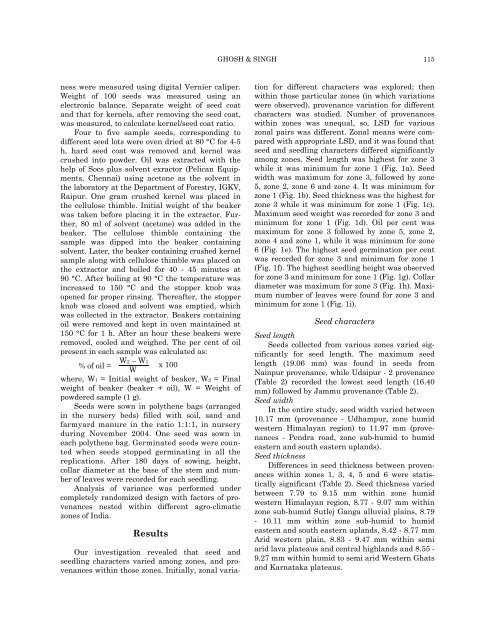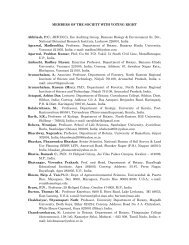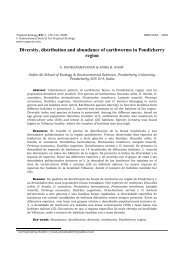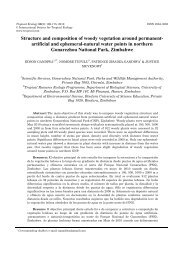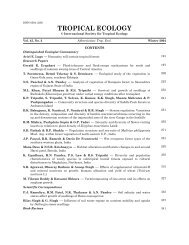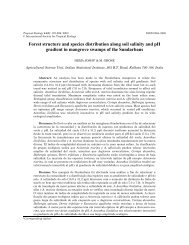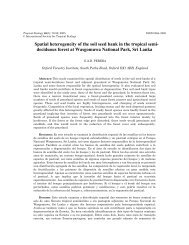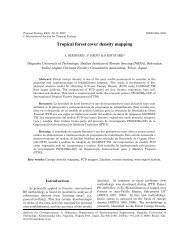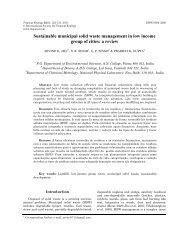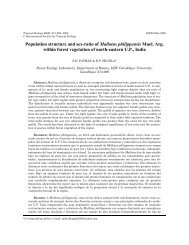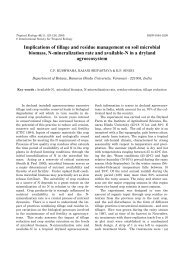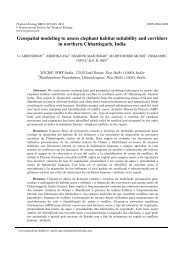Variation in seed and seedling characters of Jatropha curcas L. with ...
Variation in seed and seedling characters of Jatropha curcas L. with ...
Variation in seed and seedling characters of Jatropha curcas L. with ...
You also want an ePaper? Increase the reach of your titles
YUMPU automatically turns print PDFs into web optimized ePapers that Google loves.
GHOSH & SINGH 115<br />
ness were measured us<strong>in</strong>g digital Vernier caliper.<br />
Weight <strong>of</strong> 100 <strong>seed</strong>s was measured us<strong>in</strong>g an<br />
electronic balance. Separate weight <strong>of</strong> <strong>seed</strong> coat<br />
<strong>and</strong> that for kernels, after remov<strong>in</strong>g the <strong>seed</strong> coat,<br />
was measured, to calculate kernel/<strong>seed</strong> coat ratio.<br />
Four to five sample <strong>seed</strong>s, correspond<strong>in</strong>g to<br />
different <strong>seed</strong> lots were oven dried at 80 °C for 4-5<br />
h, hard <strong>seed</strong> coat was removed <strong>and</strong> kernel was<br />
crushed <strong>in</strong>to powder. Oil was extracted <strong>with</strong> the<br />
help <strong>of</strong> Socs plus solvent exractor (Pelican Equipments,<br />
Chennai) us<strong>in</strong>g acetone as the solvent <strong>in</strong><br />
the laboratory at the Department <strong>of</strong> Forestry, IGKV,<br />
Raipur. One gram crushed kernel was placed <strong>in</strong><br />
the cellulose thimble. Initial weight <strong>of</strong> the beaker<br />
was taken before plac<strong>in</strong>g it <strong>in</strong> the extractor. Further,<br />
80 ml <strong>of</strong> solvent (acetone) was added <strong>in</strong> the<br />
beaker. The cellulose thimble conta<strong>in</strong><strong>in</strong>g the<br />
sample was dipped <strong>in</strong>to the beaker conta<strong>in</strong><strong>in</strong>g<br />
solvent. Later, the beaker conta<strong>in</strong><strong>in</strong>g crushed kernel<br />
sample along <strong>with</strong> cellulose thimble was placed on<br />
the extractor <strong>and</strong> boiled for 40 - 45 m<strong>in</strong>utes at<br />
90 °C. After boil<strong>in</strong>g at 90 °C the temperature was<br />
<strong>in</strong>creased to 150 °C <strong>and</strong> the stopper knob was<br />
opened for proper r<strong>in</strong>s<strong>in</strong>g. Thereafter, the stopper<br />
knob was closed <strong>and</strong> solvent was emptied, which<br />
was collected <strong>in</strong> the extractor. Beakers conta<strong>in</strong><strong>in</strong>g<br />
oil were removed <strong>and</strong> kept <strong>in</strong> oven ma<strong>in</strong>ta<strong>in</strong>ed at<br />
150 °C for 1 h. After an hour these beakers were<br />
removed, cooled <strong>and</strong> weighed. The per cent <strong>of</strong> oil<br />
present <strong>in</strong> each sample was calculated as:<br />
W2 – W1<br />
% <strong>of</strong> oil =<br />
x 100<br />
W<br />
where, W1 = Initial weight <strong>of</strong> beaker, W2 = F<strong>in</strong>al<br />
weight <strong>of</strong> beaker (beaker + oil), W = Weight <strong>of</strong><br />
powdered sample (1 g).<br />
Seeds were sown <strong>in</strong> polythene bags (arranged<br />
<strong>in</strong> the nursery beds) filled <strong>with</strong> soil, s<strong>and</strong> <strong>and</strong><br />
farmyard manure <strong>in</strong> the ratio 1:1:1, <strong>in</strong> nursery<br />
dur<strong>in</strong>g November 2004. One <strong>seed</strong> was sown <strong>in</strong><br />
each polythene bag. Germ<strong>in</strong>ated <strong>seed</strong>s were counted<br />
when <strong>seed</strong>s stopped germ<strong>in</strong>at<strong>in</strong>g <strong>in</strong> all the<br />
replications. After 180 days <strong>of</strong> sow<strong>in</strong>g, height,<br />
collar diameter at the base <strong>of</strong> the stem <strong>and</strong> number<br />
<strong>of</strong> leaves were recorded for each <strong>seed</strong>l<strong>in</strong>g.<br />
Analysis <strong>of</strong> variance was performed under<br />
completely r<strong>and</strong>omized design <strong>with</strong> factors <strong>of</strong> provenances<br />
nested <strong>with</strong><strong>in</strong> different agro-climatic<br />
zones <strong>of</strong> India.<br />
Results<br />
Our <strong>in</strong>vestigation revealed that <strong>seed</strong> <strong>and</strong><br />
<strong>seed</strong>l<strong>in</strong>g <strong>characters</strong> varied among zones, <strong>and</strong> provenances<br />
<strong>with</strong><strong>in</strong> those zones. Initially, zonal variation<br />
for different <strong>characters</strong> was explored; then<br />
<strong>with</strong><strong>in</strong> those particular zones (<strong>in</strong> which variations<br />
were observed), provenance variation for different<br />
<strong>characters</strong> was studied. Number <strong>of</strong> provenances<br />
<strong>with</strong><strong>in</strong> zones was unequal, so, LSD for various<br />
zonal pairs was different. Zonal means were compared<br />
<strong>with</strong> appropriate LSD, <strong>and</strong> it was found that<br />
<strong>seed</strong> <strong>and</strong> <strong>seed</strong>l<strong>in</strong>g <strong>characters</strong> differed significantly<br />
among zones. Seed length was highest for zone 3<br />
while it was m<strong>in</strong>imum for zone 1 (Fig. 1a). Seed<br />
width was maximum for zone 3, followed by zone<br />
5, zone 2, zone 6 <strong>and</strong> zone 4. It was m<strong>in</strong>imum for<br />
zone 1 (Fig. 1b). Seed thickness was the highest for<br />
zone 3 while it was m<strong>in</strong>imum for zone 1 (Fig. 1c).<br />
Maximum <strong>seed</strong> weight was recorded for zone 3 <strong>and</strong><br />
m<strong>in</strong>imum for zone 1 (Fig. 1d). Oil per cent was<br />
maximum for zone 3 followed by zone 5, zone 2,<br />
zone 4 <strong>and</strong> zone 1, while it was m<strong>in</strong>imum for zone<br />
6 (Fig. 1e). The highest <strong>seed</strong> germ<strong>in</strong>ation per cent<br />
was recorded for zone 3 <strong>and</strong> m<strong>in</strong>imum for zone 1<br />
(Fig. 1f). The highest <strong>seed</strong>l<strong>in</strong>g height was observed<br />
for zone 3 <strong>and</strong> m<strong>in</strong>imum for zone 1 (Fig. 1g). Collar<br />
diameter was maximum for zone 3 (Fig. 1h). Maximum<br />
number <strong>of</strong> leaves were found for zone 3 <strong>and</strong><br />
m<strong>in</strong>imum for zone 1 (Fig. 1i).<br />
Seed <strong>characters</strong><br />
Seed length<br />
Seeds collected from various zones varied significantly<br />
for <strong>seed</strong> length. The maximum <strong>seed</strong><br />
length (19.06 mm) was found <strong>in</strong> <strong>seed</strong>s from<br />
Na<strong>in</strong>pur provenance, while Udaipur - 2 provenance<br />
(Table 2) recorded the lowest <strong>seed</strong> length (16.40<br />
mm) followed by Jammu provenance (Table 2).<br />
Seed width<br />
In the entire study, <strong>seed</strong> width varied between<br />
10.17 mm (provenance - Udhampur, zone humid<br />
western Himalayan region) to 11.97 mm (provenances<br />
- Pendra road, zone sub-humid to humid<br />
eastern <strong>and</strong> south eastern upl<strong>and</strong>s).<br />
Seed thickness<br />
Differences <strong>in</strong> <strong>seed</strong> thickness between provenances<br />
<strong>with</strong><strong>in</strong> zones 1, 3, 4, 5 <strong>and</strong> 6 were statistically<br />
significant (Table 2). Seed thickness varied<br />
between 7.79 to 9.15 mm <strong>with</strong><strong>in</strong> zone humid<br />
western Himalayan region, 8.77 - 9.07 mm <strong>with</strong><strong>in</strong><br />
zone sub-humid Sutlej Ganga alluvial pla<strong>in</strong>s, 8.79<br />
- 10.11 mm <strong>with</strong><strong>in</strong> zone sub-humid to humid<br />
eastern <strong>and</strong> south eastern upl<strong>and</strong>s, 8.42 - 8.77 mm<br />
Arid western pla<strong>in</strong>, 8.83 - 9.47 mm <strong>with</strong><strong>in</strong> semi<br />
arid lava plateaus <strong>and</strong> central highl<strong>and</strong>s <strong>and</strong> 8.55 -<br />
9.27 mm <strong>with</strong><strong>in</strong> humid to semi arid Western Ghats<br />
<strong>and</strong> Karnataka plateaus.


